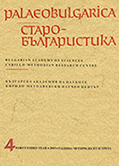Каква е била ловната птица на юношата Константин според гл. III на Пространното житие на св. Константин-Кирил
What Kind of Bird Did Young Constantine Use for Hunting according to Chapter III of the Long Life of St. Constantine-Cyril
Author(s): Maya IvanovaSubject(s): Language studies, Language and Literature Studies
Published by: Кирило-Методиевски научен център при Българска академия на науките
Keywords: Holy Brothers Cyril and Methodius; Long Life of St. Constantine-Cyril; hunting bird; Modern Bulgarian translations
Summary/Abstract: The article is based on an episode of the Long Life of St. Constantine-Cyril where the main various readings are related with the hunting bird of the youth Constantine. We could summarize the picture as follows: ꙗстребъ (in all Reading Menaia for February and part of the group of Russian collections); крагуи (in all South Slavonic copies, only 8); крагуилъ and крагуаръ are forms related to the previous крагуи, registered in the more archaic Russian copies of the Long Life. From here we start a research on the lexeme in the Modern Bulgarian translations of the Long Life. A total of 5 translations has been studied: by Nikola Nachov (1912); V. Sl. Kiselkov (1923, 1933, 1939, 1942, 1945); E. Nikolov (1934, 1942); N. Lazurin (1942, 1946); Hr. Kodov (1973, 1981, 1986), their following publications and adaptations. Special attention is paid to the editions of V. Kiselkov who edited his translation repeatedly. The discussed variants in translation show that in the years the word has gradually become an indecipherable archaism, needing a clarification; the translators therefore opted for different decisions but ultimately the word сокол (the modern word for falcon) established itself. The word соколъ is also registered in the Long Life – in the beginning of chapter XVI. The textological tradition gives no variants and the picture remains the same in the translations as well. With view of the presence of the two lexemes, an opposition of meaning is searched for on symbolical level. The discussed two short examples from the Long Life and their Modern Bulgarian examples call for the conclusion that it is high time that Cyrillo-Methodian Studies start viewing Modern translations as a separate topic. The questions when and why the necessity arises for a medieval text to be presented to a broader audience are eloquent of a nation’s cultural progress. Especially in the case of such fundamental works like the long lives of the Holy Brothers Cyril and Methodius.
Journal: PALAEOBULGARICA / СТАРОБЪЛГАРИСТИКА
- Issue Year: 2019
- Issue No: 4
- Page Range: 38-51
- Page Count: 14
- Language: Bulgarian
- Content File-PDF

